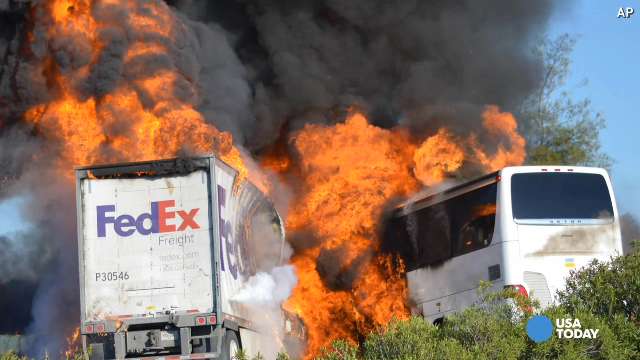WASHINGTON, DC
A fiery crash from a truck slamming into a bus and killing 10 people in Northern California prompted federal safety officials Tuesday to recommend secondary doors for motorcoaches and safety briefings before trips, like with planes and trains.
The National Transportation Safety Board couldn't determine what made the FedEx truck driver unresponsive in the bus crash April 10, 2014, along Interstate 5 near Orland. The truck driver was healthy, not under the influence of drugs or alcohol, and not using a cell phone during the crash, investigators said.
"This whole thing is really a mystery," said board member Robert Sumwalt.
But the board unanimously found that a second door in the Silverado Stages motorcoach would have allowed passengers to get out faster than jumping through windows. A safety briefing before the trip would have educated passengers about how to open the windows that left a 7-foot jump to the ground, the board found.
"We can't undo the terrible toll of that crash," said Christopher Hart, the board chairman. "We can, however, repeat our urgent message to regulators to take appropriate action to give more passengers a better chance of walking away from such a crash in the future."
The FedEx truck with two 28-foot trailers left the southbound lanes, crossed the median and collided first with a northbound car and then a Silverado Stages motorcoach filled with high-school students.
The truck driver Tim Evans and bus driver Talalelei Lealao-Taiao each died in the crash, as did eight bus passengers. Bonnie and Joe Duran, the occupants of the Nissan Altima, which spun around and left the highway, suffered minor injuries.
The bus had been filled with 43 students and three adult chaperones from Los Angeles traveling to tour Humboldt University, and the remaining passengers suffered a variety of injuries.
Investigators found that most of the fatalities were in the first two rows of the bus. But as the bus became engulfed in flames from the truck's diesel fuel, two people died in the next six rows and others were seriously injures from the flames and smoke, according to investigators.
Students ran to the back of the bus, thinking there would be an emergency exit like on school buses, investigators said.
The NTSB urged the National Highway Traffic Safety Administration to require secondary doors as emergency exits on new bus designs, and more rigorous standards for non-flammable materials inside buses, to match plane and train furnishings.
"We need to see about leveling the playing field for the different modes of transportation," board member Earl Weener said.
Sumwalt voiced the hope that Mark Rosekind, who is now head of NHTSA, would adopt the recommendations after investigating the crash at the site as a former NTSB member.
"These people were very fit," Sumwalt said. "They should have been able to get out."

At least 10 people are dead after a FedEx truck slammed into a
charter bus full of high schoolers in Northern California on Thursday
afternoon. The investigation is underway as to what caused the fatal
accident.
VPC

